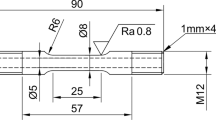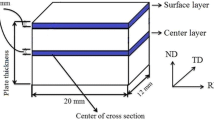Abstract
This study investigated the susceptibility of X80 pipeline steel to hydrogen embrittlement given different hydrogen pre-charging times and hydrogen charging–releasing–recharging cycles in H2S environment. The fracture strain of the steel samples decreased with increasing hydrogen pre-charging time; this steel degradation could almost be recovered after diffusible hydrogen was removed when the hydrogen pre-charging time was <8 d. However, unrecoverable degeneration occurred when the hydrogen pre-charging time extended to 16–30 d. Moreover, nanovoid formation meant that the hydrogen damage to the steel under intermittent hydrogen pre-charging–releasing–recharging conditions was more serious than that under continuous hydrogen pre-charging conditions. This study illustrated that the mechanical degradation of steel is inevitable in an H2S environment even if diffusible hydrogen is removed or visible hydrogen-induced cracking is neglected. Furthermore, the steel samples showed premature fractures and exhibited a hydrogen fatigue effect because the repeated entry and release of diffusible hydrogen promoted the formation of vacancies that aggregated into nanovoids. Our results provide valuable information on the mechanical degradation of steel in an H2S environment, regarding the change rules of steel mechanical properties under different hydrogen pre-charging times and hydrogen charging–releasing–recharging cycles.
Similar content being viewed by others
References
M.R. Louthan Jr, G.R. Caskey Jr, J.A. Donovan, and D.E. Rawl Jr, Hydrogen embrittlement of metals, Mater. Sci. Eng., 10(1972). p. 357.
P.P. Bai, J. Zhou, B.W. Luo, S.Q. Zheng, and C.F. Chen, Roles of carbon dioxide and steam on the hydrogen embrittlement of 3Cr tube steel in synthetic natural gas environment, Corros. Eng Sci. Technol, 53(2018). No. 1 p. 1.
M. Koyama, E. Akiyama, Y.K. Lee, D. Raabe, and K. Tsuzaki, Overview of hydrogen embrittlement in high-Mn steels, Int. J. Hydrogen Energy, 42(2017). No. 17 p. 12706.
A. Kawashima, K. Hashimoto, and S. Shimodaira, Hydrogen electrode reaction and hydrogen embrittlement of mild steel in hydrogen sulfide solutions, Corrosion, 32(1976). No. 8 p. 321.
B.J. Berkowitz and H.H. Horowitz, The role of H2S in the corrosion and hydrogen embrittlement of steel, J. Electrochem. Soc, 129(1982). No. 3 p. 468.
J. Woodtli and R. Kieselbach, Damage due to hydrogen embrittlement and stress corrosion cracking, Eng Fail.Anal, 7(2000). No. 6 p. 427.
F.D. de Moraes, F.L. Bastian, and J.A. Ponciano, Influence of dynamic straining on hydrogen embrittlement of UNS-G41300 and UNS-S31803 steels in a low H2S concentration environment, Corros. Sci., 47(2005). No. 6 p. 1325.
M. Monnot, R.P. Nogueira, V. Roche, G. Berthomé, E. Chauveau, R. Estevez, and M. Mantel, Sulfide stress corrosion study of a super martensitic stainless steel in H2S sour environments: Metallic sulfides formation and hydrogen embrittlement, Appl. Surf. Sci., 394(2017). p. 132.
S.H. Li, C.F. Chen, Y.N. Liu, H.B. Yu, and X.L. Wang, Influence of surface martensite layer on hydrogen embrittlement of Fe-Mn-C-Mo steels in wet H2S environment, Int. J. Hydrogen Energy, 43(2018). No. 34 p. 16728.
W.Y. Chu, L.J. Qiao, Q.Z. Chen, and K.W. Gao, Fracture and Environment Induced Cracking, Sciences Express, Beijing, 2000, p. 106.
J.P. Hirth, Effects of hydrogen on the properties of iron and steel, Metall. Trans. A, 11(1980). No. 6 p. 861.
K. Takai, H. Shoda, H. Suzuki, and M. Nagumo, Lattice defects dominating hydrogen-related failure of metals, Acta Mater, 56(2008). No. 18 p. 5158.
T. Neeraj, R. Srinivasan, and J. Li, Hydrogen embrittlement of ferritic steels: observations on deformation micro-structure, nanoscale dimples and failure by nanovoiding, Acta Mater., 60(2012), No. 13–14, p. 5160.
D.G. Xie, S.Z. Li, M. Li, Z.J. Wang, P. Gumbsch, J. Sun, E. Ma, and Z. Shan, Hydrogenated vacancies lock dislocations in aluminium, Nat. Commun., 7(2016), art. No. 13341.
M. Hattori, H. Suzuki, Y. Seko, and K. Takai, The role of hydrogen-enhanced strain-induced lattice defects on hydrogen embrittlement susceptibility of X80 pipeline steel, JOM, 69(2017). No. 8 p. 1375.
L. Wan, W.T. Geng, A. Ishii, J.P. Du, Q.S. Mei, N. Ishikawa, H. Kimizuka, and S. Ogata, Hydrogen embrittlement controlled by reaction of dislocation with grain boundary in alpha-iron, Int. J. Plast, 112(2019). p. 206.
Y. Momotani, A. Shibata, D. Terada, and N. Tsuji, Effect of strain rate on hydrogen embrittlement in low-carbon martensitic steel, Int. J. Hydrogen Energy, 42(2017). No. 5 p. 3371.
D. Pérez Escobar, T. Depover, E. Wallaert, L. Duprez, M. Verhaege, and K. Verbeken, Thermal desorption spectroscopy study of the interaction between hydrogen and different microstructural constituents in lab cast Fe-C alloys, Corros. Sci, 65(2012). p. 199.
H.S. Noh, J.H. Kang, K.M. Kim, and S.J. Kim, The effect of carbon on hydrogen embrittlement in stable Cr-Ni-Mn-N austenitic stainless steels, Corros. Sci, 124(2017). p. 63.
R.A. Oriani, The diffusion and trapping of hydrogen in steel, Acta Metall, 18(1970). No. 1 p. 147.
M.Q. Wang, E. Akiyama, and K. Tsuzaki, Effect of hydrogen on the fracture behavior of high strength steel during slow strain rate test, Corros. Sci, 49(2007). No. 11 p. 4081.
W.K. Kim, S.U. Koh, B.Y. Yang, and K.Y. Kim, Effect of environmental and metallurgical factors on hydrogen induced cracking of HSLA steels, Corros. Sci, 50(2008). No. 12 p. 3336.
K. Takai and R. Watanuki, Hydrogen in trapping states innocuous to environmental degradation of high-strength steels, ISIJ Int, 43(2003). No. 4 p. 520.
M. Koyama, C.C. Tasan, E. Akiyama, K. Tsuzaki, and D. Raabe, Hydrogen-assisted decohesion and localized plasticity in dual-phase steel, Acta Mater, 70(2014). p. 174.
T. Doshida and K. Takai, Dependence of hydrogen-induced lattice defects and hydrogen embrittlement of cold-drawn pearlitic steels on hydrogen trap state, temperature, strain rate and hydrogen content, Acta Mater, 79(2014). p. 93.
I. Moro, L. Briottet, P. Lemoine, E. Andrieu, C. Blanc, and G. Odemer, Hydrogen embrittlement susceptibility of a high strength steel X80, Mater. Sci Eng. A, 527(2010), No. 27–28, p. 7252.
X. Zhu, W. Li, H.S. Zhao, L. Wang, and X.J. Jin, Hydrogen trapping sites and hydrogen-induced cracking in high strength quenching & partitioning (Q&P) treated steel, Int. J. Hydrogen Energy, 39(2014). No. 24 p. 13031.
S.J. Kim, D.W. Yun, H.G. Jung, and K.Y. Kim, Determination of hydrogen diffusion parameters of ferritic steel from electrochemical permeation measurement under tensile loads, J. Electrochem. Soc, 161(2014), No. 12, p. E173.
F. Huang, X.G. Li, J. Liu, Y.M. Qu, J. Jia, and C.W. Du, Hydrogen-induced cracking susceptibility and hydrogen trapping efficiency of different microstructure X80 pipeline steel, J. Mater. Sci, 46(2011). No. 3 p. 715.
M. Koyama, E. Akiyama, and K. Tsuzaki, Effect of hydrogen content on the embrittlement in a Fe-Mn-C twinning-induced plasticity steel, Corros. Sci, 59(2012). p. 277.
Y.X. Chen, S.Q. Zheng, J. Zhou, P.Y. Wang, L.Q. Chen, and Y.M. Qi, Influence of H2S interaction with prestrain on the mechanical properties of high-strength X80 steel, Int. J. Hydrogen Energy, 41(2016). No. 24 p. 10412.
P.C. Okonkwo, R.A. Shakoor, A. Soliman, and A.M.A. Mohammed, Corrosion behavior of API X-80 steel in hydrogen sulfide environment at different temperatures, [in] Corrosion 2016, Vancouver, 2016.
K. Shen, L. Xu, Y. Guo, J. Shi, and M.Q. Wang, Effect of microstructure on hydrogen diffusion and notch tensile strength of large steel forging, Mater. Sci Eng. A, 628(2015). p. 149.
T. Michler, M. Lindner, U. Eberle, and J. Meusinger, Assessing hydrogen embrittlement in automotive hydrogen tanks, [in] R.P. Gangloff and B.P. Somerday eds. Gaseous Hydrogen Embrittlement of Materials in Energy Technologies, Woodhead Publishing, Cambridge, 2012, p. 94.
T. Depover and K. Verbeken, The effect of TiC on the hydrogen induced ductility loss and trapping behavior of Fe-C-Ti alloys, Corros. Sci, 112(2016). p. 308.
Y.M. Qi, H.Y. Luo, S.Q. Zheng, C.F. Chen, and D.N. Wang, Effect of immersion time on the hydrogen content and tensile properties of A350LF2 steel exposed to hydrogen sulphide environments, Corros. Sci, 69(2013). p. 164.
J. Kittel, V. Smanio, M. Fregonese, L. Garnier, and X. Lefebvre, Hydrogen induced cracking (HIC) testing of low alloy steel in sour environment: Impact of time of exposure on the extent of damage, Corros. Sci, 52(2010). No. 4 p. 1386.
W.Y. Chu, L.J. Qiao, Y.B. Wang, and Y.H. Cheng, Quantitative study for sulfide stress corrosion cracking of tubular steel, Corrosion, 55(1999). No. 7 p. 667.
G. Hultquist, M.J. Graham, J.L. Smialek, and B. Jönsson, Hydrogen in metals studied by thermal desorption spectroscopy (TDS), Corros. Sci, 93(2015). p. 324.
M. Kaneko, T. Doshida, and K. Takai, Changes in mechanical properties following cyclic prestressing of martensitic steel containing vanadium carbide in presence of nondiffusible hydrogen, Mater. Sci. Eng. A, 674(2016). p. 375.
D. Vo, A. Lipnitskii, T. Nguyen, and T.K. Nguyen, Nitrogen trapping ability of hydrogen-induced vacancy and the effect on the formation of AlN in aluminum, Coatings 7(2017). No. 6 p. 79.
H. Sugimoto and Y. Fukai, Hydrogen-induced superabundant vacancy formation by electrochemical methods in bcc Fe: Monte Carlo simulation, Scripta Mater., 134(2017). p. 20.
I.M. Robertson, P. Sofronis, A. Nagao, M.L. Martin, S. Wang, D.W. Gross, and K.E. Nygren, Hydrogen embrittlement understood, Metall. Mater. Trans. A, 46(2015). No. 6 p. 2323.
Y. Tateyama and T. Ohno, Stability and clusterization of hydrogen-vacancy complexes in α-Fe: an ab initio study, Phys. Rev. B, 67(2003), No. 17, art. No. 174105.
H.G.F. Wilsdorf, The ductile fracture of metals: a micro-structural viewpoint, Mater. Sci. Eng., 59(1983). No. 1 p. 1.
H.G.F. Wilsdorf, The role of glide and twinning in the final separation of ruptured gold crystals, Acta Metall, 30(1982). No. 6 p. 1247.
Acknowledgements
This work was financially supported by the National Natural Science Foundation of China (Nos. 51805292, 51671215, and 51425502) and the National Postdoctoral Program for Innovative Talents of China (No. BX201700132).
Author information
Authors and Affiliations
Corresponding authors
Rights and permissions
About this article
Cite this article
Bai, Pp., Zhou, J., Luo, Bw. et al. Hydrogen embrittlement of X80 pipeline steel in H2S environment: Effect of hydrogen charging time, hydrogen-trapped state and hydrogen charging–releasing–recharging cycles. Int J Miner Metall Mater 27, 63–73 (2020). https://doi.org/10.1007/s12613-019-1870-1
Received:
Revised:
Accepted:
Published:
Issue Date:
DOI: https://doi.org/10.1007/s12613-019-1870-1




